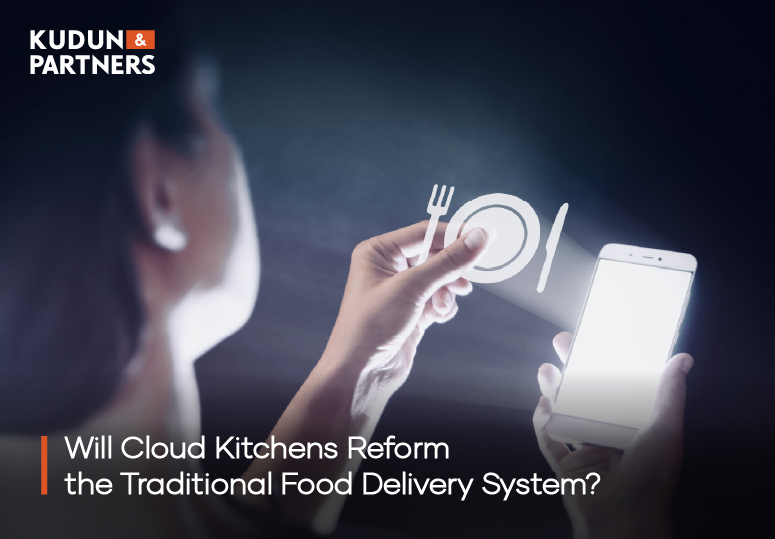The pandemic is changing society in countless ways – some temporary, and some permanent. Mandatory temperature checks near shop entrances surely won’t last forever, but many other routines and personal habits are likely to stick. Most people who use food delivery applications today will still have them on their phones in the future, having come to appreciate the convenience of enjoying entire meals simply by pressing a few buttons on their phones.
The rise of food delivery apps has the effect of lowering demand for on location food preparation and dining. All that is really needed is a cloud kitchen or ‘ghost kitchen’: The same ingredients, recipes, brand names, and labels – but without all the investment in atmosphere and table service that a traditional restaurant requires.
Standard cloud kitchens are entirely unrecognizable in person. No signs will give away their location, which may be a small concrete building or a designated corner of a warehouse. But after delivery drivers pick up and deliver each takeaway meal, their hungry customers will not know the difference.
With lower overhead in terms of property value, decoration and servers, alongside the benefit of increased convenience for customers, it is no wonder that investors see cloud kitchens as a promising model for growth. Serving people directly in their homes also provides added food safety, by lowering the risk of COVID-19 infections among customers and staff alike.
Seen in this way, the market potential for cloud kitchens is easy to recognize. It is therefore no wonder that powerhouses like Central Restaurants Group have set their sights on this model, planning to open 100 virtual kitchens in the next five (5) years, from a total investment of 500 million baht.
Still, it is worth looking more closely at the factors shaping this new market sector. The ghost kitchen idea comes in several intriguing variants, each with its own particular advantages and uses. There are also common elements to each, as well as related legal issues that investors should understand. Only by looking closer can we appreciate both the opportunities and challenges affecting this popular business trend.
Types of business models
Each cloud kitchen concept serves its purpose in different ways.
-
- A standard ghost or hybrid cloud kitchen prepares food for delivery via third-party app, with the food prepared in a dedicated facility.
- A shared cloud kitchen involves multiple food operators working alongside each other in the same property.
- An aggregator cloud kitchen is run by the delivery service provider, with orders handled by its own proprietary online order and delivery platform. Restaurant brands prepare orders within a shared kitchen space.
- A hybrid cloud kitchen has a physical location that is accessible to the public, where food preparation can be seen by visitors, and meals can either be delivered or picked up by customers as takeaway.
- A full outsource cloud kitchen collects online customer orders and delivers them to other kitchens for preparation, then picks up the prepared meals and readies them for delivery.
A recipe for success?
Before investing in the ghost kitchen model, businesses need to have a clear understanding of its pros and cons.
Benefits for investors include:
1) Reduced operating costs. Leasing a location allows ghost kitchen operators to minimize expenses for equipment, staffing, property, and all the related legal requirements. Since lease packages come in various forms, shared cloud kitchen space may also be available – further lowering costs for additional services, including security, maintenance and cleaning.
2) Smaller upfront investment. In contrast to traditional restaurants, ghost kitchens require little in the way of initial commitment. Operators can sidestep most physical setup requirements, and gain online recognition fairly quickly through digital advertisements as well as promotions within various delivery apps.
3) Greater scalability. Ghost kitchens can expand simply by adding more staff and floor space as needed, without having to purchase and decorate more prime real estate.
4) Greater control over customer interactions. By making food orders accessible through various customizable online platforms, cloud kitchens can channel customers through standard decision trees. This setup allows for greater clarity and efficiency – which can be further optimized through a dedicated online order management system using customized software.
Challenges for ghost kitchen investors include:
1) Red tape. Government permits, brand licensing issues, food safety regulations, lease agreements, and tax obligations will naturally need to be addressed by cloud kitchens. Depending on the situation, landlords may be able to make it easier to meet some of these requirements – but for operators who choose to develop their own properties and online platforms, additional software regulations and other details must still be attended to.
2) Customer experience. Virtual kitchens may produce lower levels of customer satisfaction due to the nature of food delivery. Difficulties here include managing customer patience, keeping cooked dishes at a proper temperature en route to the customer’s location, and ensuring that delivered food remains presentable.
Getting involved
The pandemic and its accompanying social distancing rules have sparked intense interest in this line of business, from customers as well as investors. Even companies without a traditional food & beverage focus are looking to get on the inside of this growing market.
Among them is airline giant AirAsia, which is moving forward with its plan to develop a ‘Super App’ by acquiring the Thai operations of Indonesia-based Gojek via a stock trade agreement. AirAsia CEO Tony Fernandes sees Gojek’s app system as a way for the airline to expand beyond its original horizons. “By taking on Gojek’s well-established Thai business, we’ll be able to turbocharge our ambitions in this space to become a leading ASEAN challenger super app,” he said.
The company’s long-term ambition is to gain a stronger foothold in the Southeast Asian e-commerce market by expanding its various non-airline-based products and services into a variety of sectors across the region. Still, the extent to which cloud kitchens will replace traditional restaurants, most of which already prepare food for delivery drivers, remains to be seen.
Although cloud kitchens largely deliver on their promise to simplify the restaurant business, while providing vastly improved scalability, the road ahead is by no means easy. Observing food safety rules, among other legal and technical requirements, can be a tough challenge – especially if complex arrangements are made among multiple parties.
If you’d like to know more about business and investment opportunities in the cloud kitchen sector, Kudun & Partners is here to help. Get in touch with us today for legal and practical guidance in this exciting new field.
About us
Food and Beverages Sector
Kudun & Partners has been at the centre of this progressive thinking. Between January 2015 and December 2018, more than US$1.6 billion of investment poured into Thailand’s food and beverage sector. We advised on several of these transactions, helping not only foreign investors in navigating the local landscape to maximise value and meet their commercial objectives but also local conglomerates seeking to expand their products and brand abroad.
Few food and beverage markets are as exciting as Thailand’s right now. We can help you make the most of it.


